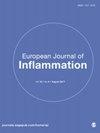Anti-inflammatory activity of ingredients from the heartwood of Vietnamese Dalbergia oliveri Gamble ex Prain
IF 0.6
4区 医学
Q4 IMMUNOLOGY
引用次数: 1
Abstract
Objectives: To investigate the phytochemical constituents of Vietnamese Dalbergia oliveri and their inhibition of NO production. Methods: The ethyl acetate soluble fraction was subjected to column chromatography using silica gel and Sephadex LH-20 to isolate compounds. The chemical structures of isolated compounds were identified by nuclear magnetic resonance data and comparison with previously reported literature. The anti-inflammation effects of the isolated compounds on the lipopolysaccharide (LPS)-induced NO production in RAW 264.7 cells were measured using the Griess reaction. Results: Nine secondary metabolites (1−9) were isolated successfully from the heartwood of D. oliveri. The chemical structures of these compounds were identified as daidzein (1), formononetin (2), 3,7-dihydroxy-4′-methoxyflavone (3), liquiritigenin (4), 3′-methoxydaidzein (5), dalbergin (6), butin (7), sativanone (8), and isoliquiritigenin (9). This is the first time that compounds 1, 3, 5−8 have been isolated from D. oliveri. In the NO production inhibition, compounds 7 and 9 exhibited the most potent inhibitory activity, with IC50 values of 7.6 and 11.2 μM, respectively, followed by 3−6, with IC50 values from 19.6 to 28.7 μM. Conclusion: The results suggested that D. oliveri and its natural products might exert anti-inflammatory effects due to their NO-inhibiting actions.越南橄榄心材成分的抗炎活性
目的:研究越南橄榄的植物化学成分及其对NO生成的抑制作用。方法:采用硅胶和Sephadex LH-20柱色谱法对乙酸乙酯可溶性部分进行分离。通过核磁共振数据和与先前报道的文献的比较,鉴定了分离的化合物的化学结构。使用Griess反应测定分离的化合物对脂多糖(LPS)诱导的RAW 264.7细胞中NO产生的抗炎作用。结果:从橄榄心材中成功分离出9种次生代谢产物(1−9)。这些化合物的化学结构分别为大豆苷元(1)、马齿苋素(2)、3,7-二羟基-4′-甲氧基黄酮(3)、甘草素(4)、3′-甲硫基大豆苷素(5)、dalbergin(6)、butin(7)、sativanone(8)和异甘草素(9)。这是首次从橄榄中分离出化合物1、3、5−8。在NO产生抑制中,化合物7和9表现出最强的抑制活性,IC50值分别为7.6和11.2μM,其次是3−6,IC50为19.6至28.7μM。结论:橄榄及其天然产物可能具有抑制NO的抗炎作用。
本文章由计算机程序翻译,如有差异,请以英文原文为准。
求助全文
约1分钟内获得全文
求助全文
来源期刊
CiteScore
0.90
自引率
0.00%
发文量
54
审稿时长
15 weeks
期刊介绍:
European Journal of Inflammation is a multidisciplinary, peer-reviewed, open access journal covering a wide range of topics in inflammation, including immunology, pathology, pharmacology and related general experimental and clinical research.

 求助内容:
求助内容: 应助结果提醒方式:
应助结果提醒方式:


